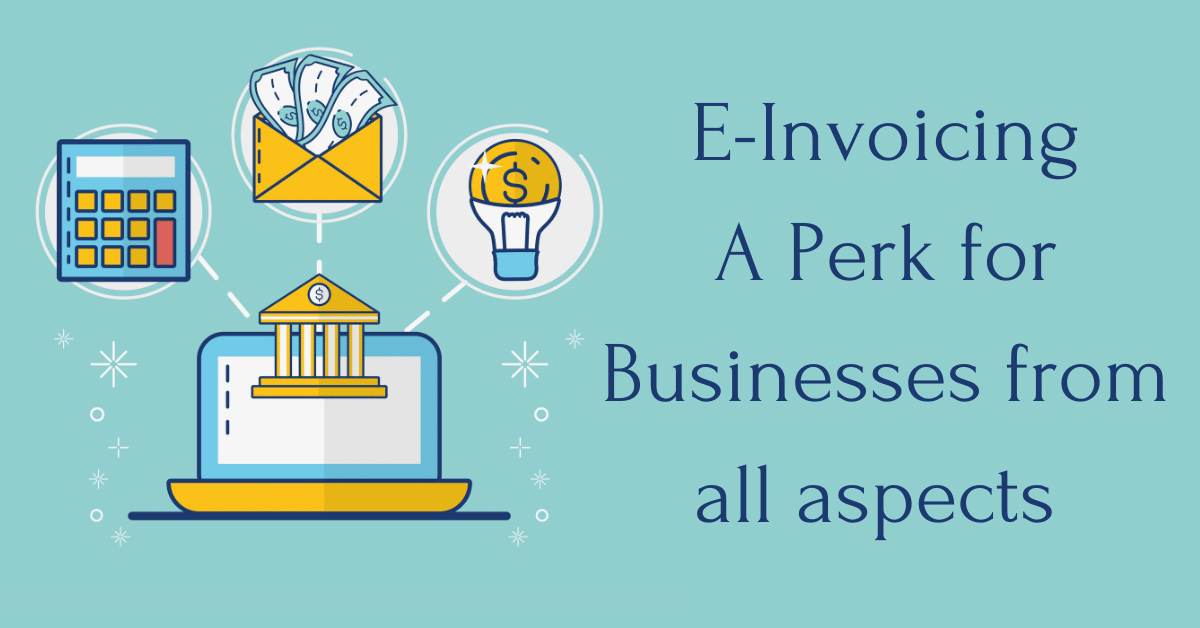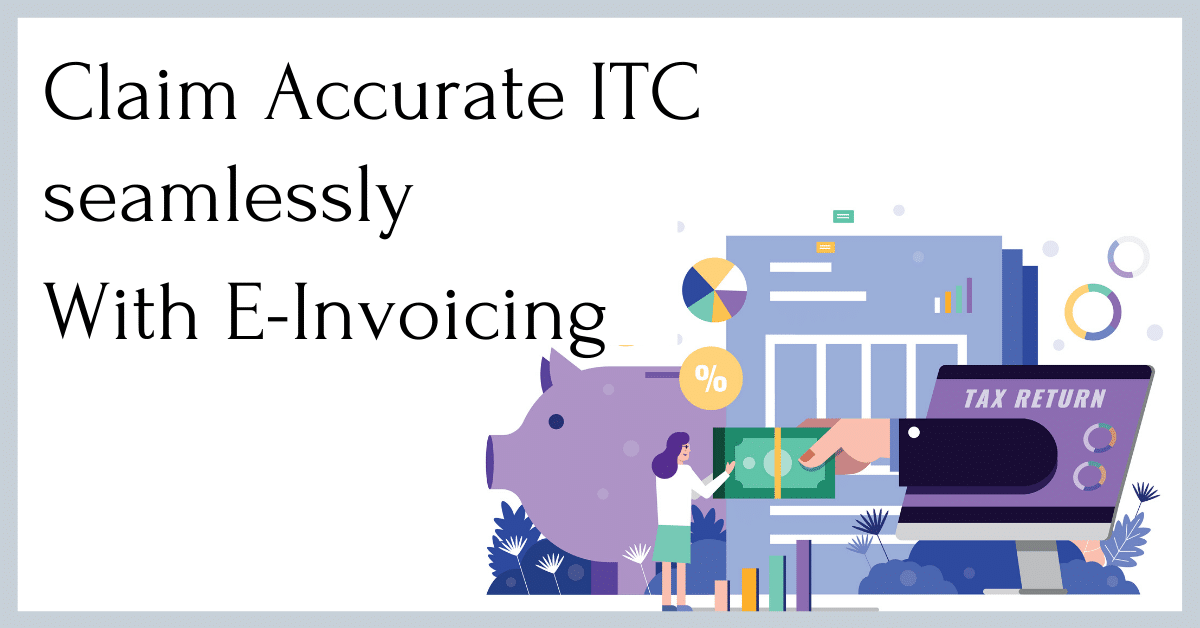What Is E-Invoicing- A Technical Aspect
The Government cannot lay enough emphasis on Revenue collection especially when it comes to Goods & Service Taxes. The GSTN wants to have a firm hand over it to cover Revenue leakage, as well as focus on better compliance of the Businesses with the GST System. To target the two, the GSTN has shot a single dart- e-Invoicing. e invoicing under gst is a tool for the Government to keep tax evasion in check as well as to make compliance as approachable as possible for the Businesses. In the 39th GST Council Meeting, it was announced that e-Invoicing shall be implemented for Businesses form October 1st, 2020.
e-Invoicing is nothing but the process of generating the Invoice in a generic for all format and uploading it for authentication in the common ‘Invoice Registration Portal’ or IRP. On successful authentication, the IRP generates a unique ‘Invoice Registration Number’ & QR Code for the invoice & the final output is known as the E-Invoice. e-Invoicing is only applicable to B2B Invoices, & these invoices are to be created in the ERPs itself.
However, there are a few other documents that only need to be uploaded in the IRP, as, Credit Notes, Debit Notes, Business to Government Invoices, Export Invoices, & Reverse Charge Invoices.
e-Invoicing shall be mandatory for all businesses with an aggregated turnover of Rs 100 Crore & above. For Business with a turnover of Rs 500 Crore+ must also print QR Codes for their B2C (Business to Customer) Invoices.
Perks Of Electronic Invoicing for Businesses
e-Invoicing surely does lengthen the Invoicing process but it reduces the work in the GST Filing Process as well as for Compliance. As the name suggests Electronic Invoicing is actually, making the Invoicing process electronic & minimizing human efforts. The electronic process is faster & more accurate since it eliminates human errors, this in all ways is advantageous for Businesses.
Following are the Benefits of e-Invoicing form the Business point of view-
- Compliance- e-Invoicing has made compliance with the GST System simpler, faster & more accurate. The data shall be auto-populated for the GSTR filings, e-way bills, & audits & ITC calculations shall be better & more precise, these two are the major concerns for Businesses currently.
- Reconciliation- The reconciliation of the data is automated, which makes reconciliation thorough & enables the Taxpayer to claim proper ITC & file their GST returns correctly & timely which eliminates chances of penalties, notices & scrutinies.
- Authentication- Authentication of the Information of each transaction keeps the Business & the taxpayer in the clear in the eyes of the GSTN. This clears or at least reduces the chances of Tax audits or any other mistakes. This also enables real-time tracking of the transactions of the business.
- ITC claim- As a result of thorough & crystal clear reconciliation, the ITC claim becomes coherent. The various matchings of the reports of GSTR-1, GST-2A, & GSTR-3B, makes it easier to identify the defaulting supplier and try to clear the mismatches to claim a precise ITC.
- Auto-population of data- The data for filing the GST return filing is auto-populated viz the E-Invoices so registered on the IRP. This reduces the Businesses’ efforts to find and consolidate the data form all the transactions of the month. Also, Part-A of the E-Way Bill is auto-generated from the E-Invoices.
- IRN & QR Code- IRN-QR Code are the best features of e-Invoicing, an IRN or Invoice Reference Number is a unique number given to each E-Invoice post-authentication. The IRN is proof of the authenticity of the Invoice. And a QR Code is also printed on the E-Invoice, which enables the user to get quick access to important details of the Invoice just by scanning the QR Code.
Understanding ITC & the role of E-Invoicing- A complete guide
ITC or Input Tax Credit is claiming the tax that a taxpayer has paid at the time of purchase, & adjusting it with the due Tax liability. However, the buyer must make sure that the tax paid by him to the supplier, has reached to the Government. If the supplier is a defaulter & does not pay the tax to the Government then, in that case, the buyer is not eligible for ITC.
Here is an example for a better understanding, Mr. Mehta received their GSTR-2A for January, as per which they had a purchase of Rs. 1 Lakh upon which they paid a tax of Rs. 18 Thousand to the supplier. Mr. Mehta also made a sale of Rs. 10 Lakh in the same month upon which he had a tax liability of Rs. 1,80,000.
Since all his suppliers had rightly filed their GSTRs, & Mr. Mehta has already paid Rs. 18,000 tax in the form of purchase the amount can be adjusted from their Sale Tax & thus he only needs to pay Rs. 1,62,000 (Rs. 1,80,000-Rs. 18,000, i.e. Tax liable- ITC).
Now, take another situation, if a supplier misses a particular sale in their Sales Return, or does not file their sales at all, or does not pay the tax, then in such cases problems arise for the Buyer, as per the new ITC Rule.
Earlier, a buyer could claim full ITC mentioned in their Purchase Book, irrespective of whether their Supplier had mentioned it in their GSTR-1 or not. If a certain purchase is shown in their Purchase Book (Not GSTR-2A), the Buyer could claim 100% ITC whether their suppliers had filed their Return & paid taxes or not for that transaction. This led to fraud & higher amounts of ITC claims. To tame such fraudulent activities, the government introduced a new rule.
The new 10% Provisional ITC Rule 36(4) has been implemented by 38th GST Council Meeting on 18th December 2019. As per the rule, a taxpayer can only avail extra 10% of ITC not reflecting in their GSTR-2A. The Taxpayer can, however, contact their Suppliers to file the Return, & when the Supplier does, then in that month the taxpayer can claim the ITC again.
Example- Mr. Mehta had a total ITC of Rs. 1 Lakh as per their Purchase Book, but as per their GSTR-2A they are only eligible for Rs. 60,000, as for the other transactions their Suppliers had not filed GSTR-1 due to which the purchase did not reflect in Mr. Mehta’s Purchase Return (GSTR-2A). Now as per the new 10% Provisional ITC Rule, Mr. Mehta can claim the Rs. 60,000 mentioned in their GSTR-2A, but not the remaining Rs. 40,000. Rather, they can claim 10% of what is mentioned in their GSTR-2A i.e. 10% of Rs. 60,000 which is Rs. 6,000. So Mr. Mehta can claim a total amount of Rs. 60,000 + Rs. 6,000, which is Rs. 66,000.
This is a crucial Rule for Businesses because it tightens the grip of the GSNT over taxpayers for compliance. It is a smart move indeed from the Government viewpoint, but for Businesses, it can have practical impacts like a huge loss. Like in the above Example, Mr. Mehta lost Rs. 34,000, the same can be claimed if their supplier filed the Sale Invoice in the upcoming month, although if the supplier fails to file the invoices in their GSTRs then the Buyer cannot claim ITC whatsoever.
Now e-Invoicing can help the Taxpayer in claiming precise ITC & saving tremendous losses. Since the supplier must authenticate their Invoice through e-Invoicing & report these Invoices in the IRP portal, transparency increases & the supplier cannot hide their invoices & sales. The same E-Invoice data is used to auto-generate Sales & Purchase Annexures, for GSTR filings. Hence the reconciliation will be thorough & as a result, the ITC shall be precise & clear to both, the Buyer & the GSTN. Hence e-Invoicing is a supporting tool for Businesses for accurate ITC claiming.
Make E-Invoicing Better & Simpler with APIs
e-Invoicing is nonetheless a highly efficient & supportive change for the Businesses but as compared to the old invoicing process is rather lengthier. Similar to e-Way Bills, the e-Invoicing process involves multiple steps like downloading & maintaining JSON Files and transferring data from ERP to the Portals & vice versa.
APIs are highly efficient solutions to this problem, and one such API provider is GSTHero. GSTHero is an authorized GST Suvidha Provider that provides robust & reliable API solutions. It provides Integration plug-ins for ERPs, so the user doesn’t have to juggle between the IRP & ERP with JON Files, which later they will have to convert in other formats.
With GSTHero, you will only need minimal steps to authenticate your Invoices, without having to go to the IRP. Simply generate the Invoice in the ERPs and click on generate E-Invoice tab. Simple & hasslefree e-Invoicing with GSTHero & ERP Integration, in a single click, without even logging into the IRP. GSTHero is 100% Secure & is authorized by the Government.
GSTHero portrays high efficiency, rigidity, has the ability to handle volume & new constantly changing trends of GST, is secure, & provides 100% after-sale support.
e-Invoicing is a blessing for Businesses, given the process is shortened, & GSTHero is just the final flourish that makes it even better.
About the Author- – Prachi W- Is a researcher and writer from the field of core Finance, with a writing experience in the field of Business Market and Business Taxes. She has been into the Taxation field for more than 2 years and in the field of writing for over an year. She researches & analyses the latest trends in GST & Business Taxes to write detailed and perceptive articles about them.




